 Our Flickr pool's Great Beyond gives us "Broken Obelisk at night"
Our Flickr pool's Great Beyond gives us "Broken Obelisk at night"
The cuts have already come down.
Now they come down again, but this time with more shock, more force, more impact. Straight from Olympia. Tens of millions will be lost in this saga. But the tens of millions tally up to something more profound than cash: the loss of minds. Young minds who want to learn. Wise minds who want to teach.
Our minds, if we let this happen as a region.
The University of Washington, like every kindergarten, elementary, junior and high school and higher learning institution in our country is facing a war of historical dimensions.
What is this war about?
It is about whether we should measure the worth of knowledge and thinking with a calculator. It is about whether a free, thriving and independent learning academy has a place in our society. It is about whether our state and our citizens envision a future where knowledge for the sake of future knowledge is a value....

Type "rain" into the search box in our Flickr pool and you get great results. Thanks to :MPG: for the "red rain gear" and the reminder that inclement weather doesn't mean unfashionable weather.
I think this is the fifth rule of Fight Club: Don't lean on someone's parked car in Belltown. In horrific college news, the Medical Examiner's office has ruled a UW student's death this week a suicide, and about a dozen Central Washington University students overdosed at a party last night--worse, it seems the drugs were slipped into girls' drinks as part of a plan for sexual assault.
Money is too tight to mention; Susan Hutchison says even people who make $200,000 a year don't feel rich anymore. Also at PubliCola, Josh Cohen breaks down the Mayor's $13-million Walk Bike Ride plan to show that the lion's share goes to pedestrian improvements. Not that budget discourse is marked by an openness to reasonably "share the pain"--at this point, everyone's decided to hang separately. My favorite quote? "[E]ven though fewer people are watching public access, most people want it available."
HorsesAss knew the Seattle Times was going to endorse Patty Murray ages and ages ago. Just FYI. TechFlash chronicled Microsoft's crazy week (including this sign of the apocalypse: No more full payment of employees' health insurance premiums). What will it take to make Goldman Sachs happy?
Ballard stinks, let's just admit it and move on. Our Seattle Canoe and Kayak Club is at the Pan American Championships, winning stuff, reports My Green Lake. Speaking of North Seattle stuff, there's now a NorthSeattleGuide.com that offers local business deals. The UW does not wish to be known as the Fiery Couch college, please make a note of it. Wallingford: sucking the fun out of Halloween since 2010. Queen Anne seems really amped about their new Than Bros. pho stop....
Now University of Washington students can snork down all the street food they want without leaving campus, during the Husky Union Building (HUB) renovation. No hurry, y'all have until September 2012 to sample the goods at Red Square. The kids don't have to stand out in the rain and snow, of course--there are also "expansions at multiple locations such as By George, Eleven 01 at Terry/Lander, and 8 at McMahon."
We sent SunBreak street food correspondent Lucas Anderson out to provide photographic proof of the al fresco dining options, and he has delivered. You can read all about UW's street food here, but here's Lucas's thumbnail guide if you're pressed for time:
- Hot dog place: Hot Dawgs - $4 hot dogs, with specialty relishes. Vegan sausage too!
- Burger place: Red Brick BBQ - $7 'sammichez' with $2 sides (slaw, beans, and potato salad). No vegetarian option.
- Taco place: Siganos - $2 tacos, $6 taco plate (tacos with beans and rice). Vegan/vegetarian option. I tried a couple of vegan tacos, and it was a pretty good snack for only four bucks. Better than the oily Thai food or the same old pizza they used to have in the HUB. ...
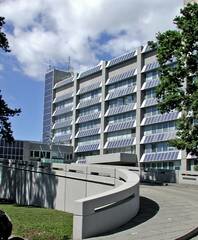 We are the Evergreen State, after all. David Bramer, of the U.W.'s Green Futures Research and Design Lab (GFL), is one of nine U.S. landscape architecture students selected to draft a sustainable landscape for the U.S. Mission to the United Nations in Geneva, Switzerland.
We are the Evergreen State, after all. David Bramer, of the U.W.'s Green Futures Research and Design Lab (GFL), is one of nine U.S. landscape architecture students selected to draft a sustainable landscape for the U.S. Mission to the United Nations in Geneva, Switzerland.
The team will be joined by three Swiss students and will be overseen by three U.S. landscape architecture faculty. The project is a collaboration with the American Society of Landscape Architects (ASLA) to create a comprehensive, sustainable landscape design for the Mission building grounds. Here's the details:
The prominence of the Mission building in international Geneva and the fact that it is regularly visited by diplomats and political figures from around the world were factors when the U.S. State Department selected Geneva as its "Flagship Post for Energy and Sustainability." The building is the site of the installation of the largest solar energy project ever undertaken by the Department of State overseas and home to an innovative magnetic levitation (MaglevTM) chiller air conditioning system that runs a virtually friction-free compressor.Conserving the variety of plant and animal life is also a priority, and in 2009 the Mission became the first State Department facility to earn certification by the U.S. National Wildlife Federation as a Certified Wildlife Habitat. Seeking ways to further improve the sustainability of the building and grounds the Mission formed a Green Team which developed the concept with ASLA to recruit students for a collaborative sustainable design project. The students were selected by a committee which included representatives from ASLA and the Department of State. Applicants were required to be U.S. citizens and to submit a résumé; 400-word- statement of interest; faculty recommendations; and three samples of project work.
"I am very excited about this project, which will help reinforce the Mission’s reputation as the greenest US diplomatic building in Europe," said Ambassador Betty E. King, U.S. Permanent Representative to the United Nations in Geneva. "The efforts of this talented team of young landscape architects will not only help us make our environment more sustainable, but also provide our staff with an inspiring and healthy environment which we will enjoy for years to come."
...
The Geneva region is a major international center for conservation and the environment. The city is home to the European headquarters of the U.N. Environment Program, and to major organizations such as the World Meteorological Organization (WMO) and the Intergovernmental Panel on Climate Change (IPCC). Nearby Gland is the site of two of the world’s most important conservation organizations: the World Wide Fund for Nature (WWF) and the World Conservation Union (IUCN). During their stay in Geneva the students will also have an opportunity to visit some of these organizations, to meet with international diplomats, UN staff and NGOs, and to exchange ideas with major players in the environmental community in Switzerland.
Read the full press release here.
The New York Times seems delighted to dispel any remaining myths about the untouched natural beauty of Washington state. Just this week readers have learned that there's three times the amount of plutonium waste at Hanford as "thought," and that the Puget Sound's pH level is declining in part due to ocean acidification and the water is growing more corrosive. (Thanks. We'll be expecting a make-up "36 Hours in Seattle," soon.)
The Seattle Times goes straight to the pH-decline bottom line: the impact on the Puget Sound shellfish industry.
The Taylor Shellfish hatchery on Hood Canal's Dabob Bay had its first good year in several in 2009, but company spokesman Bill Dewey said he suspects that's merely because the winds cooperated, preventing acidified seawater from entering the relatively stable bay.
The company recently installed sophisticated pH monitors at its hatchery to determine when it's best to draw water off the surface, from way down deep—or not at all.
In an earlier story, from January this year, the Seattle Times looked at the cause-and-effects of ocean acidification in general. The world's oceans act as a carbon dioxide sink, claiming excess CO2 from the atmosphere, but CO2 dissolved in water creates a weak acid solution. It turns out that shellfish larvae, for one, are very sensitive to changes in pH.
The new study on the Puget Sound's ocean-acidification intake represents the work of researchers with NOAA, the University of Washington, and the state's Department of Ecology. (It's published in the latest issue of Estuarine, Coastal and Shelf Science.) The researchers make it clear that the Sound is struggling mightily with the human activity around it--the toxic pollution and "nutrient-rich" flows that are channeled into it, both killing off life and promoting algae blooms that...also kill off life....
 This is SDOT's hilariously small detour map, perhaps trying to mask the miles involved.
This is SDOT's hilariously small detour map, perhaps trying to mask the miles involved.
This is a different viaduct, but its repair is also going to cause significant traffic disruption. The North 45th Street Viaduct is a bridge extending east of the University of Washington, down the hill to the University Village. It's a major thoroughfare, giving communities to the east I-5 access, and of course channeling shoppers right to the U Village.
SDOT is closing the bridge entirely from June 14 (after UW commencement) to September 10. They'll be working as fast as possible, from 7 a.m. to 11 p.m., and perhaps later, because they need to get this project done before the 15th Avenue NE repaving project, running from Pacific Avenue NE to NE 55th Street, starts up in 2011. (15th Avenue NE is a major element in the Viaduct detour plan.)
Constructed in 1938, the Viaduct carries over 20,000 cars each day, on average. SDOT has determined that the 468-foot west approach has reached the end of its safe lifespan (the east approach has already been retrofitted). They're replacing the wooden timbers with a different support to make the bridge significantly stronger, but otherwise, the $30-million repair won't change the current traffic flow: two westbound lanes, one eastbound lane, a pedestrian walkway.
SDOT's FAQ (updated last in March) says traffic will be detoured to Pacific Avenue to the south and 65th to the north (see map). There is no easy way around this: "SDOT is still considering how to direct regional traffic on Interstate‐5 trying to reach specific destinations such as Seattle Children's Hospital, the University of Washington, or University Village." Metro's bus #25 and Seattle Children's Hospital and UWMC shuttles will have to be rerouted. As of March, SDOT did not anticipate any closures to the Burke-Gilman Trail.
There is only one thing to say about the detour routes: Yikes! The south detour especially, taking Pacific to Montlake (or vice versa) will take years off your life during commute times. Essentially, just one more reason why I don't travel north of the Montlake Cut. My condolences if you live there.
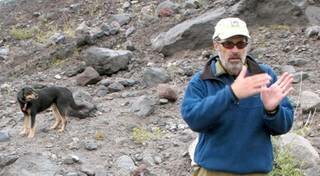 Steve Malone, on Mount St. Helens with Scooter the seismo-dog
Steve Malone, on Mount St. Helens with Scooter the seismo-dog
"The longer it's been since the last earthquake," said Steve Malone, brightly, "the sooner it is 'til the next one." We were in his office at the University of Washington--he's retired from full-time seismologizing, but still spends unpaid hours on campus answering questions from pesky bloggers, even if they're fueled by sensationalist speculation about more frequent quakes.
He refocused my question away from end-time paranoia toward common sense acceptance: "We have several of these faults: there's the Seattle Fault, and there's one down in the Tacoma basin, one up at Everett and Whidbey Island…so if you say, we've got eight or ten of these faults, even if the earthquakes go once every thousand years, you sum them up, you could have something every few hundred years of some consequence," explained Malone. "You don't know, it could be 500 years, or it could be tomorrow."
He also assured me that, incredible as it seems, it's perfectly plausible that the recent Baja quake could have generated waves at a Ballard pool. "Large earthquakes generate big surface waves, and big surface waves generate a bit of a tilt as they go through. If a body of water's natural free period happened to be the same as the frequency of those surface waves, then after a couple of cycles you might see it get built up enough," said Malone. "The motions of surface waves can be on the order of centimeters. We just don't feel it because it's very slow."
As an afterthought, he added: "The Denali quake of 2002--bigger than Baja [7.9] but further away--it generated a sloshing in Lake Union that damaged houseboats."
And because I had to ask: "Tunnels aren't usually an issue with earthquakes. The motion underground is less than on the surface, and they're already built to withstand the pressures of everything else."
As it turned out, we ended up talking across the breadth of Malone's career, covering volcanic earthquakes, megathrust quakes, and the mysterious Episodic Tremor and Slip (ETS). His interest in seismology developed in graduate school; he'd studied physics as undergraduate, but was not "keen on modern physics" and gravitated toward geology, then seismology. At first he enjoyed the outdoors aspects of the work, "particularly in the volcano world," but as his research progressed, he ended up in the office running computer models.
"Since I retired I get to go out and play," he said, smiling. "I volunteer for all sorts of fieldwork." He's been up on Mount Rainier working on an upgrade of instruments there, and out on the Olympic Peninsula conducting ETS studies in advance of the next appearance of the phenomenon.
"The ETS we have here are fairly regular, every 14 and a half months or so. The next one is scheduled--if you can call it that--for sometime mid-summer, maybe mid-August. We've got some experiments we're planning to gear up and get extra equipment in the ground for. There's some extra equipment out there now, running in background mode, but when the ETS arrives we'll double the equipment, trying to look ever closer at it."...
BNET is doing a series on ten "boom towns" across the nation where job growth is predicted to enter the double-digit range between 2008 and 2018. Jobs of the future, they say, will go "to the cities with the industries and the entrepreneurial incentives in place to support a highly educated, tech-savvy workforce."
Seattle makes that boom town list, with a 12 percent increase. We're "building on past successes":
For decades, it spawned companies that grew into job-creation machines--and stuck around the area with those jobs: Boeing, Microsoft, Amazon.com, Starbucks, Costco, Expediters International, and even retail stalwart Nordstrom, which opened its first store there at the beginning of the 20th century.
While not free of the scent of PR puffery, this is based partly on Bureau of Labor Statistics projections, with a side bet on demographic trends: right now, the largest two age groups are 50-year-olds and 20-year-olds. The hypothesis is that 50s set will come to Seattle for the pre-retirement lifestyle, while the 20-somethings will flock to the UW.
Before you yawn, and produce a thick volume of past "boom towns of the future" that are still anxiously awaiting the railroad to arrive, consider this rundown of quarterly results:
- Starbucks beat analysts' expectations
- Amazon's sales soared
- Microsoft set a revenue record
- Boeing's profit margins are up
And Nordstrom had strong March sales and Costco is increasing its cash dividend. This is exactly the kind of thing that makes Seattle seem like its own little business oasis.
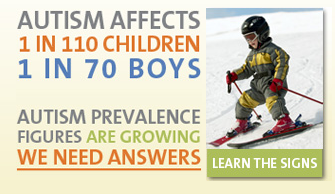 From the Autism Speaks website
From the Autism Speaks website
Sallie Tisdale has an article in Harper's (subscribers only) this month about her autistic daughter. There's an element of forestalled explanation to it; yes, she said "daughter."
My daughter, Annie, still lives with us. She is twenty-six now and at the moment is sitting on the porch, looking out at the street. Soon she will come in and pace for a while, her head down. Later she will read the first few pages of a book—the same book, the same pages, that she read last week and the week before, and will read again tomorrow.
"Autistic son" delivers 175,000 results on Google. "Autistic daughter," just 31,000. People are not sure why more boys than girls are found to have autism. Epidemiologically, the ratio is supposed to be about 3.6 boys to one girl.
It's known that girls can learn to mask some of the effects of autism more easily than boys, so it's possible that they are under-diagnosed in general. Studies show that hallmarks like "language deficits, tantrums, and aggression are all less common in girls than boys in the general population." A British researcher raises the specter of a shadow population of "shy" girls who like to keep lists and count calories (even to anorexia).
Tisdale's story is a primer on autism's variability, and its effects on everyone who struggles with it, including caregivers. Tisdale recounts the lifelong challenge of it: the official optimism with which her daughter was handed off as she finished school, the time her daughter started hallucinating and had to be given antipsychotic medication. Writes Tisdale:
Long-term studies of people with autism are not reassuring. Autistic adults generally read poorly, have few math skills. Very few go to college, are employed, or lead independent lives. The majority say they have no friends....
(more)
 The UW runs a very expensive canoe trip.
The UW runs a very expensive canoe trip.
700 students pack into a Biology 180 class at the University of Washington these days, reports the Seattle Times. TAs are assigned 60 students each. Students get clickers for real-time pop quizzes. There are weekly, short-answer online exams that are made anonymous and returned to the students so they can correct a classmates' test.
Undergraduate tuition for state residents for 2009-10 is $7,125 not including fees. (In 1996, UW tuition was $3,136, up from $2,178 in 1991.) The latest increase was a double-digit percentage, but in general increases of four to five percent have come along every few years, giving everyone an instructive course in the power of compound interest, and what happens when you key tuition value to a "market rate" generated by a feedback loop.
This seems to explain why Washington state got an "F" in affordability from the 2008 Measuring Up report on higher education....
At halftime of Washington's blowout hoops win over Cal on Saturday, fans were treated to what we were told was the 13th annual mascot basketball game. Participants included the Red Robin Restaurant Robin, "Doppler" of the Seattle Storm, the Ivar's Clam (rather handicapped as it has no arms), and UW's own Harry the Husky. Words cannot do this event justice. To the slideshow!
Texas Tech's last-second shot had swished through the net, I had uttered the word "shit," the Huskies were standing in shocked disbelief, TTU students were storming the floor, and my friends and I really wanted to watch the Oregon/Oregon State football game.
So we switched over to that game--the winner of which would go to the Rose Bowl. We saw a few plays when I noticed something odd on the scoreticker at the bottom of the screen: "Washington 90 Texas Tech 90 End 2nd."
"Go back! Go back!" Indeed, back on ESPN2, the officials had ruled after a replay review that Texas Tech's Mike Singletary had released his apparent game-winning shot a split-second after the clock hit zeroes. Students off the court. Game on.
But we had already moved on, emotionally. It's early. It's tough to win on the road. The Dawgs missed a bunch of free throws. Now we had to reprocess the possibility of a win--or once again deal with the pain of a loss.
As it turned out, it was the latter. In overtime, the Huskies fell behind, then were sunk by a terrible Matthew Bryan-Amaning inbounds pass that Texas Tech converted into a lay-in for a four-point lead.
Texas Tech hit their free throws and won the game without needing a last-second shot. The fans stormed the court yet again. You can watch highlights here.
Seattle's other D1 team, Seattle U, also lost last night. The Redhawks were even worse from the free-throw line, missing 26 out of 48 free throws. Can't win that way. The 85-74 loss came at Cal Poly and their coach, former Seattle U head man Joe Callero. Rough.
The Huskies' next game is Sunday night at Hec Ed against Cal State Northridge, an NCAA tourney team last year (though they lost most of the players off that team). Seattle U plays Saturday at UC Davis.
Producer/director and Oregon State University professor Andrea Marks is at the University of Washington tonight, December 3, to talk about the history of Polish posters and screen her documentary Freedom on the Fence.
From WWII through the fall of Communism, Polish posters commented on everything, everywhere, despite the regime's attempts at control and censorship. Eventually, if something was important to the social, political and cultural life of Poland, you said it with a poster.
It's a free event, thanks to the UW Polish Studies Endowment Committee and the Polish Home Foundation, and after the film you're invited to browse an exhibition of Polish posters, "The Polish Poster: A Visual Metaphor," curated by Ewa and Krzysztof Poraj-Kuczewski. (If you can't make the screening, the exhibit shows at the UW Allen Library North until January 15, 2010.)
- Freedom on the Fence screens Thursday, December 3, 2009, at 7 p.m. at Kane Hall, Room 110.
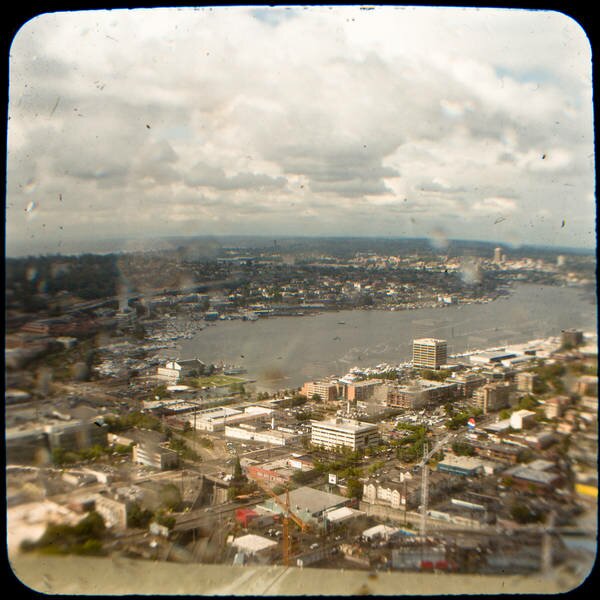 "Lake Union" from the Space Needle, courtesy of The SunBreak Flickr pool stalwart Slightlynorth
"Lake Union" from the Space Needle, courtesy of The SunBreak Flickr pool stalwart Slightlynorth
Zeitgeist, Google calls it. For me, the list echoes of Lawrence Durrell's Spirit of Place. These are ten search terms that are unique to Seattle in their popularity. Some need no explanation, like the leader "sounders fc." The Sounders Football Club has singlehandedly brought back scarf-wearing to Seattle sports fandom, if that gives you any idea. I think they could bring back umbrellas! Seriously.
But what about "bellevue college"? Yes, Virginia, there really is a college in Bellevue (previously Bellevue Community College). In 2008-09 it conferred its first Baccalaureate degrees. It's the third-largest higher learning institution in Washington, that's all. 37,000 people attend.
Next we have "seahawks 2009 schedule." What does that tell us? That the Seahawks play San Francisco this weekend, for one thing. But more importantly, we learn that Seattleites are prone to rubbernecking at train wrecks. Can't help themselves.
Next! Let's take a trip to the "snoqualmie casino," with its daily blackjack tournaments, 1,700 slot machines, and ten poker tables. It's 170,000 square feet, with eight restaurants, lounges, and bars. There's an 11,000-sq.-ft. ballroom. Michael McDonald is going to appear there this weekend.
Here is something historic: "west seattle blog" is fifth on the popularity list. It is the only time that West Seattle has been fifth at anything! Tracy Record and Patrick Sands run the blog night and day, and have full-time since Tracy left KCPQ in December 2007. Today they have great shots of the moonrise from West Seattle.
I think it has to be another record that "uw libraries" makes the list. Libraries in Seattle enjoy the fame and adulation that, say, Studio 54 did in New York. A lot of you can recall Suzzallo and Odegaard without hesitation, but what about the Miller Horticultural Library? What about the K. K. Sherwood Library at Harborview? The UW libraries contain 7.14 million volumes.
I don't imagine I need to spend much time on "myuw.com." Big research university, brings in about $1 billion in grants annually, has over 4,100 full-time faculty and almost 50,000 students, there's a football team....
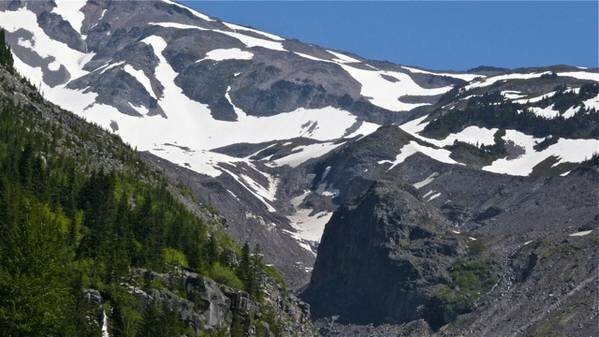 Closer to home, Mount Rainier's glaciers have retreated, too.
Closer to home, Mount Rainier's glaciers have retreated, too.
The Copenhagen Diagnosis is out (23MB download here), authored by 26 researchers, one of whom is Eric J. Steig, professor of Earth and Space Sciences at the University of Washington. The report updates the last IPCC assessment in 2007, with the general tone being that, even then, the speed of climate change was underestimated.
In just one instance, the area of the Arctic's summer sea-ice that melted between 2007 and 2009 was about 40 percent more than the IPCC model average. Earlier, the models were off by as much as 80 percent: Over the past 15 years, the sea level has risen more than five centimeters, almost most double 2001 IPCC projections. At the time, various people dismissed those as "doomsday" predictions.
UW News quotes Steig as saying the Copenhagen Diagnosis "articulates a much clearer picture of what has to happen if the world wants to keep future warming within the reasonable threshold of 2 degrees Celsius that most scientists believe is prudent."
Steig also says if you've been paying attention to research results since 2007, you may not be all that surprised. However, if you've been told repeatedly that climate change has stopped, or pointed toward the effects of solar forcing, you might be taken aback. So that is really what the "diagnosis" does, is survey the climate change field and bring everyone up to date.
It's disquieting to read, then, that despite all the rhetoric around climate change, carbon dioxide emissions from fossil fuels in 2008 grew by 40 percent from 1990. That, too, was unanticipated. UW professor Edward Miles emphasizes to UW News that while the IPCC has consistently led with non-worst-case climate change forecasts, the growth in fossil fuel emissions since 2005 does exceed the worst-case scenarios of the IPCC.
The report concludes that to keep the sea level rising three to six feet, as ice caps and sheets reach a tipping point, we need to reduce CO2 emissions by...well, that's not going to happen. And I have bulletproof models of past political action to back me up on that. Maybe look into this option instead.
With a suspected 2,600 cases of swine flu at Washington State University in Pullman (and no slowdown in students reporting sick), it's no surprise that the University of Washington has reported two suspected cases of H1N1, too. Unofficially, last weekend's PAX attendees have reported over 100 cases, renaming the virus H1Nerd1.
So far, #paxflu sufferers are tweeting what it's worth remembering, despite the size of the outbreak: while it's not pleasant, it's not for most people a particularly terrible flu. If you get sick, stay home and don't spread it. And please don't drag yourself to a large conference or convention.
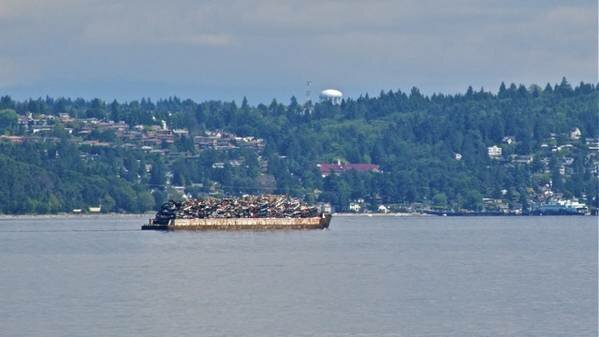
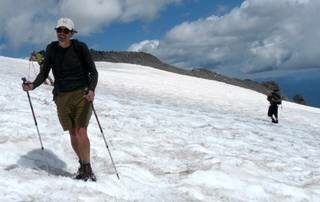
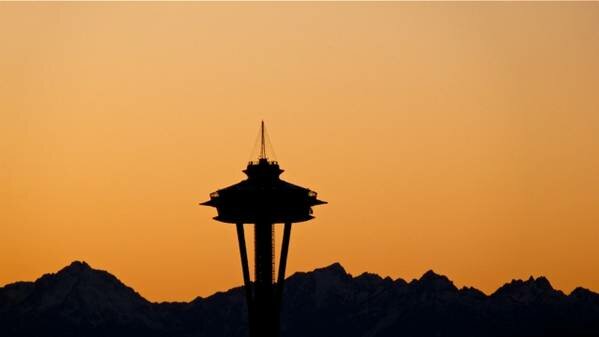
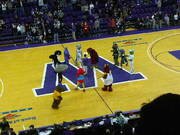

Most Recent Comments